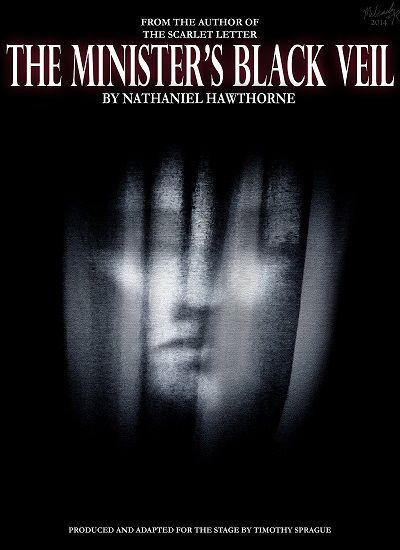
“The Minister’s Black Veil” is an allegorical story in which the parson of a small New England town, Reverend Hooper, abruptly starts wearing a black veil. The townsfolk are all tremendously disturbed by the sight of his veil; his fiancée breaks off their engagement after he refuses to remove or explain it. The flimsy cloth veil becomes the subject of much speculation, rumor, and fear:
In this manner Mr. Hooper spent a long life, irreproachable in outward act, yet shrouded in dismal suspicions; kind and loving, though unloved and dimly feared; a man apart from men, shunned in their health and joy, but ever summoned to their aid in mortal anguish. In truth, his own antipathy to the veil was known to be so great that he never willingly passed before a mirror nor stooped to drink at a still fountain lest in its peaceful bosom he should be affrighted by himself. This was what gave plausibility to the whispers that Mr. Hooper’s conscience tortured him for some great crime too horrible to be entirely concealed or otherwise than so obscurely intimated. Thus from beneath the black veil there rolled a cloud into the sunshine, an ambiguity of sin or sorrow, which enveloped the poor minister, so that love or sympathy could never reach him. It was said that ghost and fiend consorted with him there. (Hawthorne)
Hawthorne’s evocation of the uncanny — the Freudian concept of the unsettlingly strange in the familiar — in his description of the townsfolk’s reactions to the plain black veil are effective. They’re all familiar with veils, and a veiled woman would pass without much remark in their community, but a veiled minister? He’s a transgression they can’t stand, but must, because he’s their spiritual authority. They’re too afraid of his religious power to even ask him why he’s wearing the veil:
Thus they sat a considerable time, speechless, confused and shrinking uneasily from Mr. Hooper’s eye, which they felt to be fixed upon them with an invisible glance. Finally, the deputies returned abashed to their constituents, pronouncing the matter too weighty to be handled except by a council of the churches, if, indeed, it might not require a General Synod.
Within the Puritan world of Mr. Hooper and his parishioners, clearly the veil is a portentous symbol to the townsfolk: “The subject had reference to secret sin and those sad mysteries which we hide from our nearest and dearest, and would fain conceal from our own consciousness, even forgetting that the Omniscient can detect them.”
The Reverend in his black veil sets himself apart from their society by violating their social mores: an honest man should show his face. At the same time, he forces the townsfolk to come face-to-face with their own sins, guilt, and mortality symbolized by his veil, and they despise him for it.
I can see echoes of the minister in his black veil in other works, most notably in the portrayal of the King in his pallid mask in Robert Chambers’ The King In Yellow:
Camilla: You, sir, should unmask.
Stranger: Indeed?
Cassilda: Indeed it’s time. We all have laid aside disguise but you.
Stranger: I wear no mask.
Camilla: (Terrified, aside to Cassilda.) No mask? No mask!
The King in Yellow, Act I, Scene 2.
The minister’s black veil functions as a mask that hides sympathetic human features while it reveals the darkness in the wearer’s and observer’s souls, and that uncanny juxtaposition is inherently terrifying.
Leave a Reply
You must be logged in to post a comment.